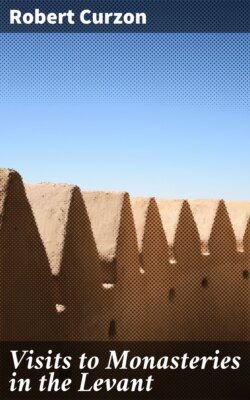Читать книгу Visits to Monasteries in the Levant - Robert Curzon - Страница 11
На сайте Литреса книга снята с продажи.
CHAPTER V.
ОглавлениеTable of Contents
Interview with Mohammed Ali Pasha—Mode of lighting a Room in Egypt—Personal Appearance of the Pasha—His Diamond-mounted Pipe—The lost Handkerchief—An unceremonious Attendant—View of Cairo from the Citadel—Site of Memphis; its immense extent—The Tombs of the Caliphs—The Pasha's Mausoleum—Costume of Egyptian Ladies—The Coboob, or Wooden Clog—Mode of dressing the Hair—The Veil—Mistaken Idea that the Egyptian Ladies are Prisoners in the Harem; their power of doing as they like—The Veil a complete Disguise—Laws of the Harem—A Levantine Beauty—Eastern Manners—The Abyssinian Slaves—Arab Girls—Ugliness of the Arab Women when old—Venerable Appearance of the old Men—An Arab Sheick.
It was in the month of February, 1834, that I first had the honour of an audience with Mohammed Ali Pasha. It was during the Mahomedan month of Ramadan, when the day is kept a strict fast, and nothing passes the lips of the faithful till after sunset. It was at night, therefore, that we were received. My companion and myself were residing at that time under the hospitable roof of the Consul-General, and we accompanied him to the citadel. The effect of the crowds of people in the streets, all carrying lanterns, or preceded by men bearing the mashlak, blazing like a beacon on the top of its high pole, was very picturesque. The great hall of the citadel was full of men, arranged in rows with their faces towards the south, going through the forms and attitudes of evening prayer under the guidance of a leader, and with the precision of a regiment on drill.
Passing these, a curtain was drawn aside, and we were ushered at once into the presence of the Viceroy, whom we found walking up and down in the middle of a large room, between two rows of gigantic silver candlesticks, which stood upon the carpet. This is the usual way of lighting a room in Egypt:—Six large silver dishes, about two feet in diameter and turned upside down, are first placed upon the floor, three on each side, near the centre of the room. On each of these stands a silver candlestick, between four and five feet high, containing a wax candle three feet long, and very thick. A seventh candlestick, of smaller dimensions, stands on the floor, separate from these, for the purpose of being moved about; it is carried to any one who wants to read a letter, or to examine an object more closely while he is seated on the divan. Almost every room in the palace has an European chandelier hanging from the ceiling, but I do not remember having ever seen one lit. These large candlesticks, standing in two rows, with the little one before them, always put me in mind of a line of life guards of gigantic stature, commanded by a little officer whom they could almost put in their pockets.
Mohammed Ali desired us to be seated. He was attended by Boghos Bey, who remained standing and interpreted for us. The Pasha at that time was a hale, broad-shouldered, broad-faced man: his short grey beard stuck out on each side of his face; his nostrils were very much opened; and, with his quick sharp eye, he looked like an old grey lion. The expression of his countenance was remarkably intelligent, but excepting this there was nothing particular in his appearance. He was attired in the Nizam dress of blue cloth. This costume consists of a red cap, a jacket with flying sleeves, a waistcoat with tight sleeves under it, a red shawl round the waist, a pair of trousers very full, like trunk hose, down to the knee, from whence to the ankle they were tight. The whole costume is always made of the same coloured cloth, usually black or blue. He had white stockings and yellow morocco shoes.
